Towing vehicles and trailers
Towing a trailer requires additional driving skills and safety precautions. The trailer may be a caravan or camper trailer, boat trailer, horse float or special-purpose trailer.
The driver of the vehicle is legally responsible for being safe when towing a trailer, and ensuring the towing vehicle, trailer and tow couplings meet the minimum standards and loaded mass limits.
They will also find the drive more enjoyable if the combination is well designed and set up, and not overloaded.
Using a suitable vehicle
Safe towing starts with ensuring the tow vehicle is suitable to tow the trailer. You can select the right trailer or caravan to match your tow vehicle or buy a tow vehicle to suit your trailer type and towing needs.
While modern vehicles are lighter and provide better service for normal motoring, some don’t have the necessary characteristics for towing.
The owner's manual usually indicates the maximum weight and other trailer features that are appropriate for the vehicle. You should not exceed these limits.
Towing will affect your vehicle in several ways, including:
- decreased acceleration and braking performance
- reduced vehicle control and manoeuvrability
- increased fuel consumption.
Therefore, when assessing the load, consider the weight of the tow vehicle and trailer, including:
- the number of passengers you intend to carry
- the equipment in the tow vehicle, such as tools and camping gear
- modifications to the tow vehicle, such as bull bars, long-range fuel tanks, supplementary batteries and roof racks
- the load on the trailer or caravan:
- caravan – may include water tanks, gas bottles, food and drink, clothing, toys
- boat trailer – may include fishing gear, safety equipment, boat motor and fuel
- horse float – may include weight of the horses, tackle and food
Helpful tip
Purchasing supplies and filling water tanks when you arrive at your destination will reduce the load on the trip there. This will save you money on fuel consumption, make the drive more enjoyable and support the local community when travelling in regional Queensland.
Remember to drain the water tanks before travelling to your next destination.
If the vehicle was manufactured before 1 January 1992 and the manufacturer hasn’t specified a maximum towing capacity, use these towing capacities as a guide:
- 1.5 times the unloaded mass of the vehicle—if the trailer is fitted with appropriate brakes
- a maximum of 750kg—if the trailer isn’t fitted with brakes.
If you’re unsure about the combined mass of the trailer and load, have it weighed at a public weighbridge.
If necessary, the manufacturer, the dealer or a specialist in towing equipment may be able to fit special suspension or transmission options, or load-distributing devices, to the tow vehicle.
Note: You may tow a trailer with an Aggregate Trailer Mass (ATM) that exceeds the towing vehicle's rated towing capacity provided the trailer is not loaded to exceed the rated towing capacity.
Legal requirements
- The vehicle and trailer must be roadworthy and registered.
- The trailer must have a lit rear number plate that is not obscured accessories, such as bicycle racks.
- Towbars and couplings must not cover the towing vehicle’s number plate or rear lights when the trailer is not connected.
- You may tow only 1 trailer (caravan, box or boat) at a time.
- People must not ride in trailers/caravans.
Helpful tip
A removable tow coupling can be removed when not in use. This will avoid blocking the number plate and minimise the hazard to people walking behind the vehicle.
While driving
When towing a trailer (including caravans), remember to:
- allow for the extra length and width of the trailer when entering traffic
- allow for its tendency to ‘cut in’ on corners and curves
- accelerate, brake and steer smoothly and gently to avoid swaying
- allow for the effects of cross-winds, passing traffic and uneven road surfaces
- leave a longer stopping distance between you and the vehicle ahead; increase the gap for longer, heavier trailers and allow even more distance in poor driving conditions
- use a lower gear in both manual and automatic vehicles when travelling downhill to make your car easier to control and reduce the strain on your brakes
- allow more time and distance to overtake and avoid ‘cutting off’ the vehicle you are overtaking when returning to the left lane
- fit a reversing camera or get someone to watch the rear of the trailer when you reverse—reversing is difficult and takes practice
- not hold up traffic—pull off the road where it is safe to do so, and where it won’t create a build-up of traffic unable to overtake
- be aware that your vehicle and trailer will have a tendency to sway when a heavy vehicle overtakes you.
Using a suitable trailer
There are many trailer types and sizes that perform different tasks.
(The images below are from the Vehicle Standards Bulletin and are used with permission from the Australian Department of Infrastructure, Transport and Regional Development and Communications.)
Caravan
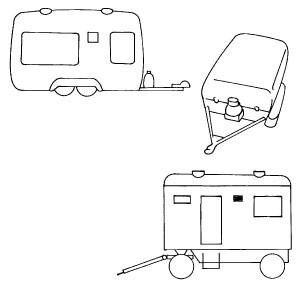
Box trailer
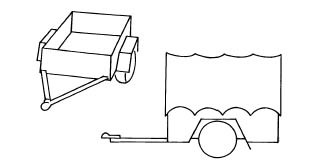
Tray body

Boat trailer
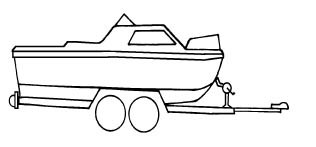
Car trailer
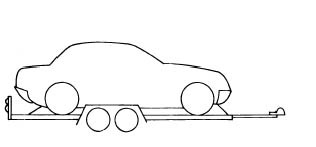
Horse float
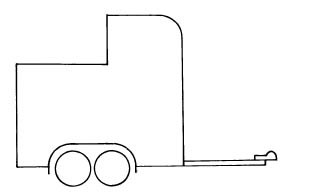
Plant trailer
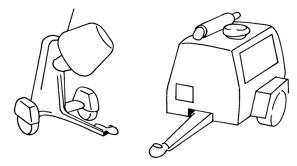
Different types of trailers can have different configurations, which affect the way the load rests on the tow vehicle.
Pig trailer
A trailer with one axle group near the middle of the load. Part of the load rests on the tow hitch of the towing vehicle.

Dog trailer
A trailer with 2 axle groups. The front axle group is steered by connection to the tow vehicle. Most of the load rests on the trailer.
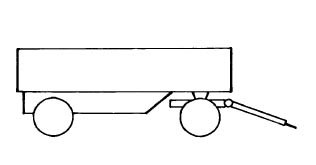
Semi-trailer (fifth wheeler)
A trailer with one axle group towards the rear end of the length of its goods-carrying surface, meaning significant load rests on the tow vehicle. The tow hitch is in front of the rear axle of the tow vehicle.
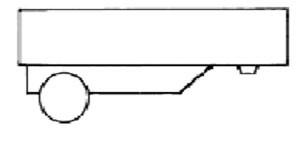
It’s important to select the right trailer type and configuration for easier load distribution and restraint. Contact RACQ or Caravanning Queensland for advice on selecting a suitable trailer or caravan combination.
Towing equipment
Your vehicle needs to be equipped appropriately for the trailer’s type and size, including:
- tow bars and couplings of a suitable type and capacity
- electrical sockets for lighting
- suitable brake connections if required
- extra mirrors for towing large trailers if required
- optional rear-view camera—these help to see traffic behind you but do not replace the need for mirrors.
Read more about towing equipment and attachments.
New trailers (building or importing)
From 1 July 2023, all trailers will need to meet full compliance to the relevant Australian Design Rules (ADRs). Vehicle Standards Bulletin 1 (VSB1) will no longer be accepted as an alternative method of compliance for new trailers.
Low Volume VINS (LVV) will no longer be issued for light trailers by us after this date and will be issued by the Australian Department of Infrastructure, Transport and Regional Development and Communications when certifying a new trailer.
Trailer inspections
In Queensland, light trailers with an aggregate trailer mass (ATM) of 751–4,500kg need a current safety certificate when they’re:
Trailers with an ATM of more than 4,500kg need a current certificate of inspection at all times, unless exempt. Find out more about registering or transferring heavy trailers.
Loading
It is unsafe and illegal to overload a trailer. Ensure the load is properly secured to the trailer.
Read more about transporting loads safely.
Maintenance
Maintain all your towing equipment regularly, including vehicle and trailer, to ensure safe towing.
Ask your trailer or vehicle dealer, RACQ or other competent service agent to check that the:
- towing vehicle and trailer are in a roadworthy and safe condition
- trailer’s wheel bearings, suspension and brakes are in good working condition.
This is particularly important for a boat trailer or a trailer that hasn’t been used for some time.
Insurance
In Queensland, most trailers do not need compulsory third party (CTP) insurance if they are being towed by a Queensland registered vehicle. Check with the CTP insurer of your towing vehicle to see if cover is provided to the trailer being towed. Visit the Motor Accident Insurance Commission website for more information .
A trailer, including a caravan, may not be covered by comprehensive insurance if:
- it doesn’t comply with Queensland registration and vehicle standard legislation
- its on-road mass exceeds your vehicle’s towing capacity
- it’s not roadworthy or safe
- it’s overloaded.